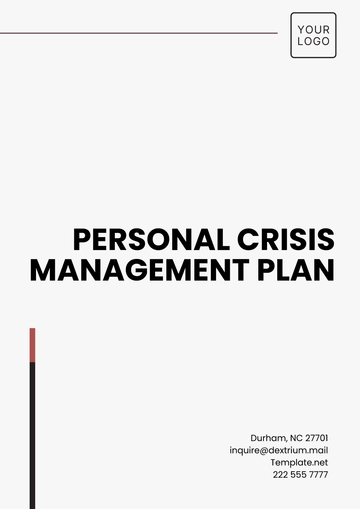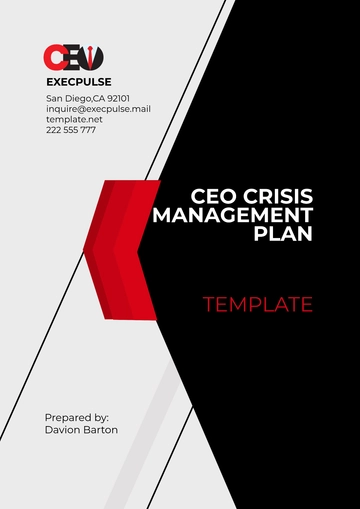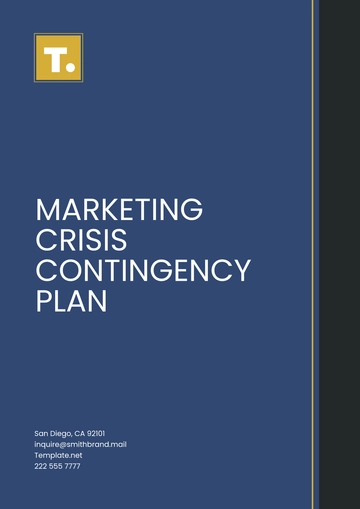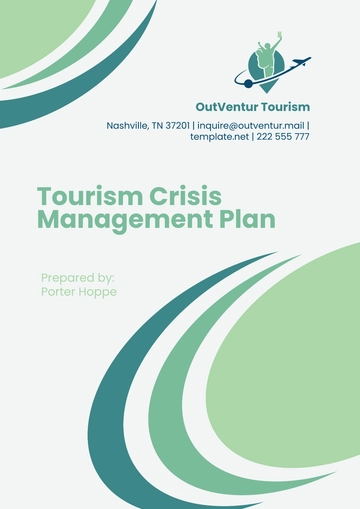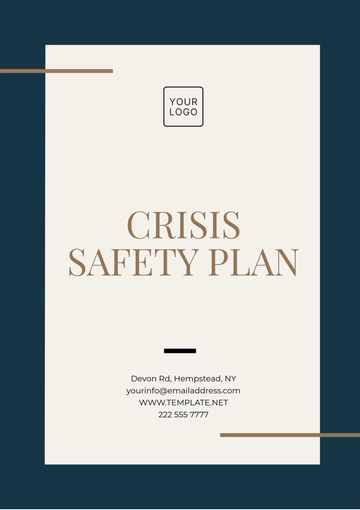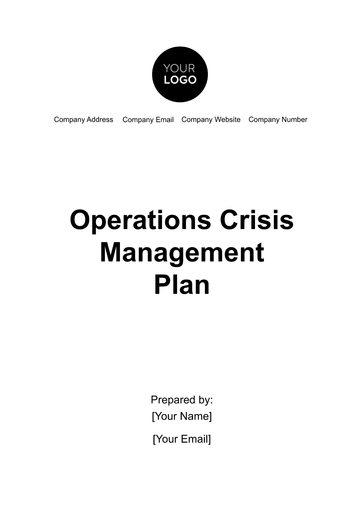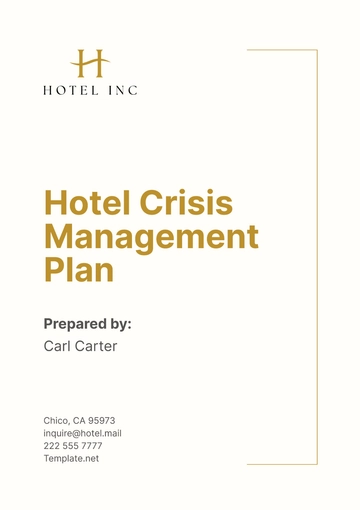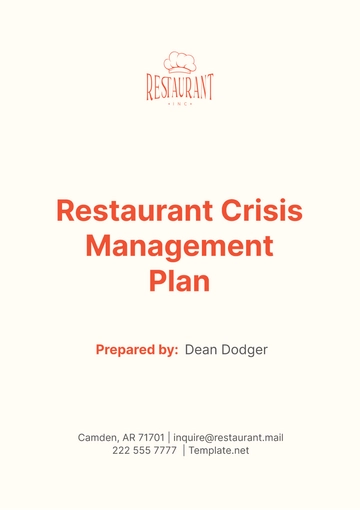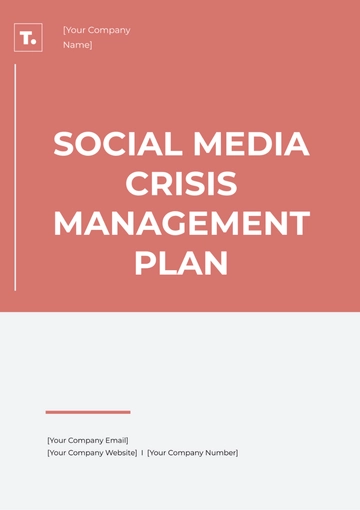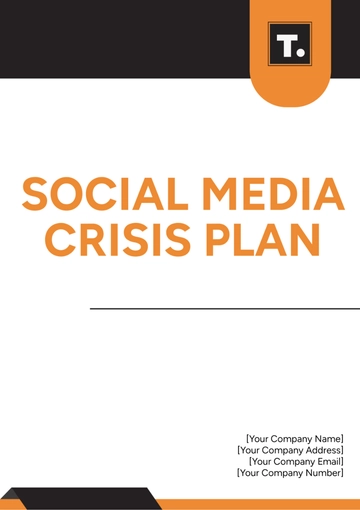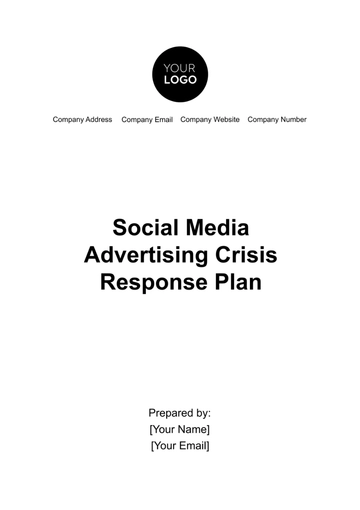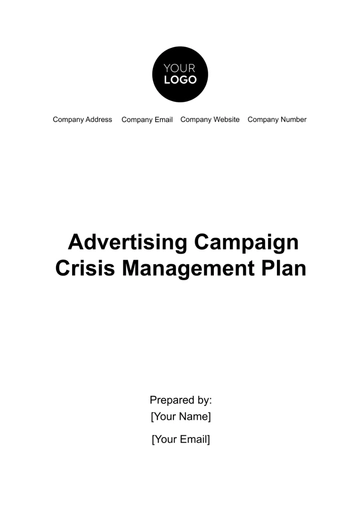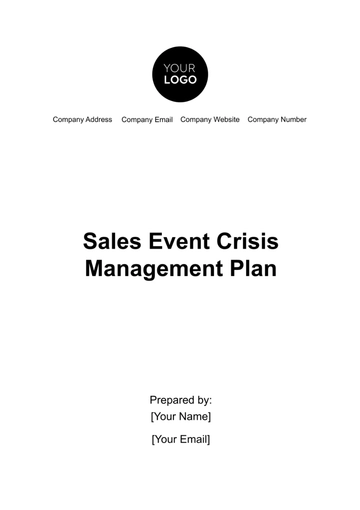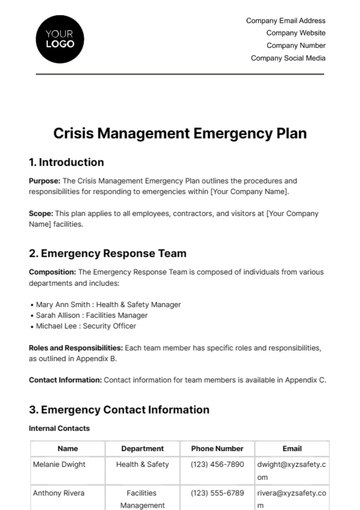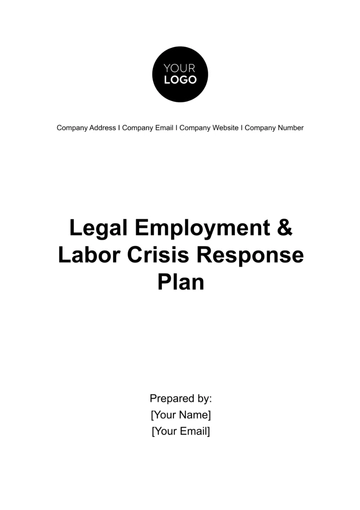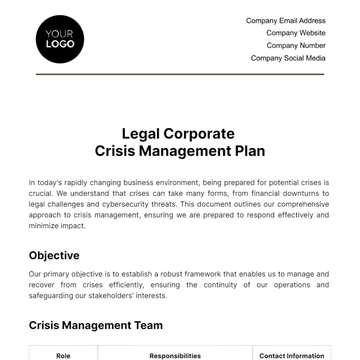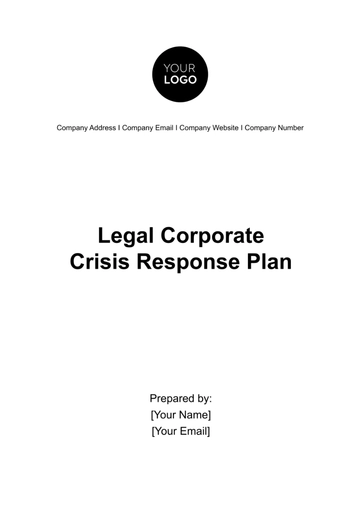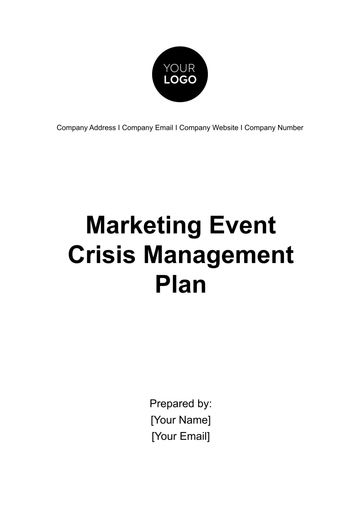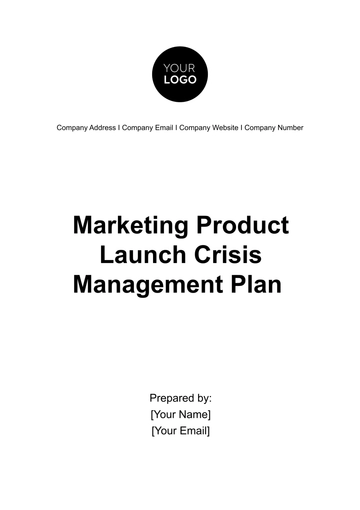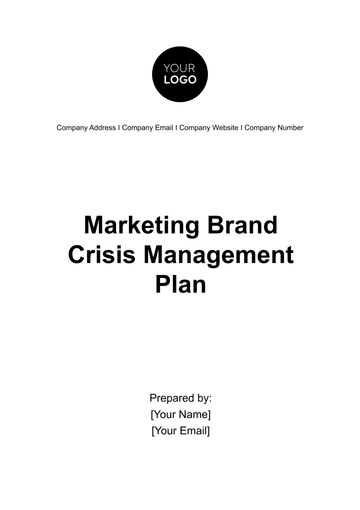Free Marketing Product Launch Crisis Management Plan
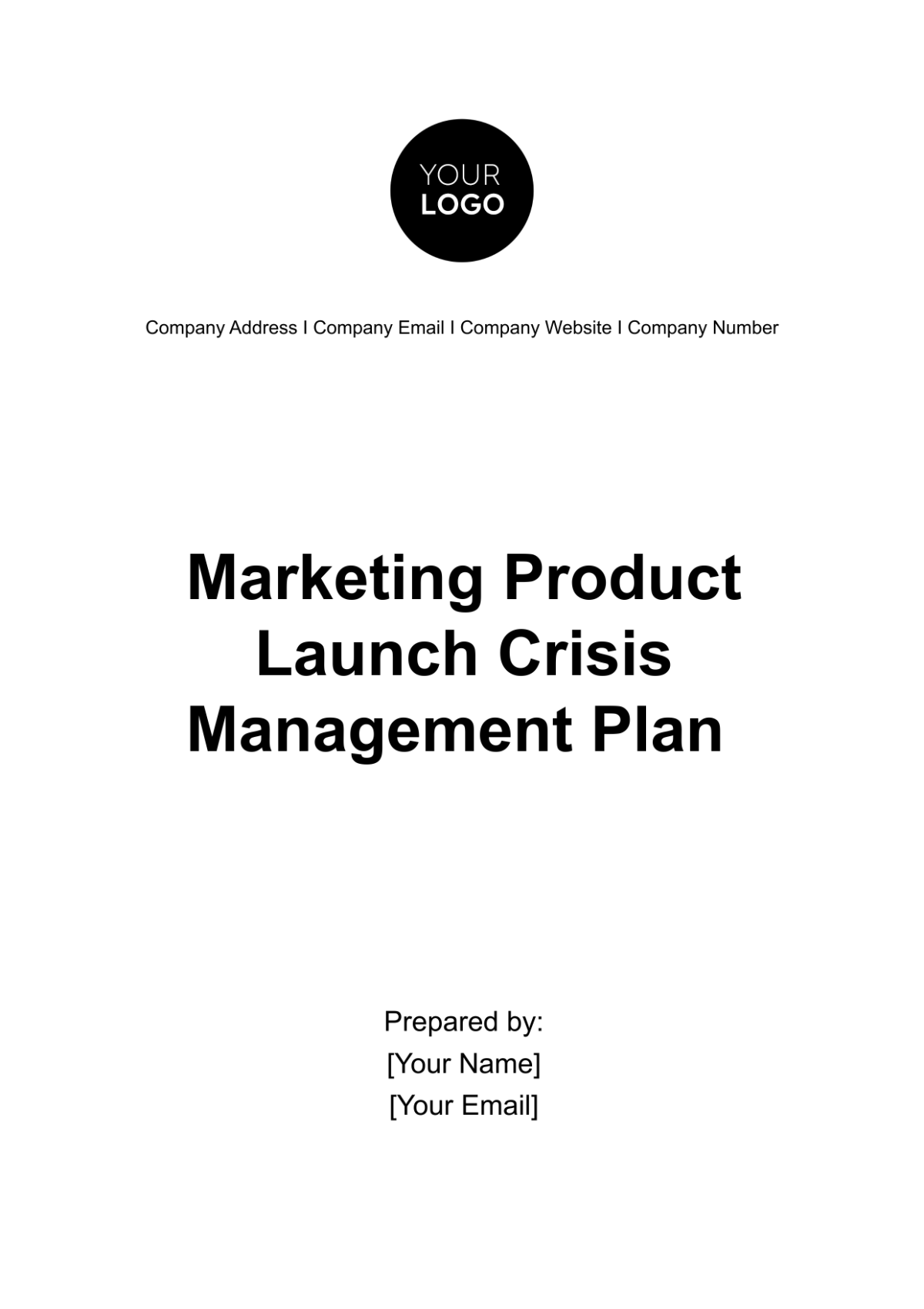
Introduction and Overview
Purpose: This Marketing Product Launch Crisis Management Plan outlines the strategies and procedures to effectively manage and mitigate potential crises that may arise during the launch of our innovative product, "EcoCleanPro." The primary goal is to safeguard [Your Company Name]'s brand reputation and minimize negative impacts on sales and customer trust.
1.1 Document Overview
This document serves as a comprehensive guide for [Your Company Name]'s marketing and communications team to navigate potential crises during the "EcoCleanPro" launch. It provides detailed insights into how to prepare for, respond to, and recover from unforeseen challenges that may threaten the success of our launch.
1.2 Product/Service Overview
"EcoCleanPro" represents a revolutionary cleaning solution that addresses the growing need for eco-friendly and effective cleaning products. Its key features and benefits include:
Feature 1: "EcoCleanPro" is made from 100% natural and biodegradable ingredients, making it safe for the environment.
Benefit: Provides a guilt-free and sustainable cleaning experience.
Feature 2: The advanced cleaning formula of "EcoCleanPro" tackles tough stains and grime on various surfaces.
Benefit: Ensures a sparkling clean and hygienic environment.
Feature 3: "EcoCleanPro" comes in eco-conscious packaging, reducing plastic waste and promoting responsible consumption.
Benefit: Appeals to environmentally-conscious consumers.
Our product's unique selling points and eco-friendly approach position it as a game-changer in the cleaning industry, offering unmatched value and sustainability to our target audience.
2. Team Structure and Responsibilities
At [Your Company Name], we understand the critical importance of a well-organized crisis management team to handle potential issues during the "EcoCleanPro" launch. The following dedicated team members are responsible for specific roles:
2.1 Crisis Management Team
Team Leader: | John Smith |
Role: | As the Team Leader, John Smith is responsible for overall coordination and decision-making during crises. He will ensure that our response aligns with our strategic goals. |
Contact: | john.smith@example.com, 222 555 7777 |
Team Leader: | Sarah Johnson |
Role: | Sarah Johnson serves as our primary point of contact for external communication, maintaining transparency and trust with our customers, partners and the media. |
sarah.johnson@example.com, 222 555 7777 |
Team Leader: | Emily Davis |
Role: | Emily Davis is responsible for developing and executing our internal and external communication strategy, ensuring consistent messaging and timely updates. |
emily.davis@example.com, 222 555 7777 |
Team Leader: | Michael Anderson |
Role: | Michael Anderson plays a critical role in providing technical insights and solutions during crises, ensuring we address any technical challenges effectively. |
michael.anderson@example.com, 222 555 7777 |
2.2 Team Responsibilities
Each member of the crisis management team has specific responsibilities during a crisis:
Team Leader: The Team Leader is the central point of coordination and decision-making, overseeing the crisis response and ensuring alignment with our strategic objectives.
Spokesperson: The Spokesperson is the voice of [Your Company Name] during crises, responsible for conveying accurate and reassuring information to the public, media, and stakeholders.
Communication Manager: The Communication Manager orchestrates both internal and external communication efforts, maintaining transparency within the organization and providing timely updates to external audiences.
Technical Expert: The Technical Expert offers specialized technical insights and solutions to address technical challenges promptly, ensuring the smooth resolution of crises.
These roles and responsibilities are vital for an effective response to any crisis that may arise during the "EcoCleanPro" launch. Clear communication channels and decision-making authority are key elements of our crisis management strategy.
3. Risk Assessment
As we gear up for the "EcoCleanPro" launch, it's crucial to proactively identify potential risks and crises that could impact its success. In this section, we outline a couple of potential risks and assess their impact and likelihood.
3.1 Potential Risks
Risk | Impact | Likelihood |
|---|---|---|
Supply Chain Disruption | High | Medium |
Negative Public Perception | Medium | Low |
3.2 Risk Mitigation
To minimize the likelihood of these identified risks and ensure a smooth "EcoCleanPro" launch, we have put in place a series of precautionary measures:
Quality Control: We have implemented rigorous quality control processes and stringent testing procedures to uphold the highest standards for "EcoCleanPro." This approach will significantly reduce the risk of quality-related issues affecting our launch.
Contingency Planning: In anticipation of potential supply chain disruptions, technical hiccups, or other unforeseen obstacles, we have developed comprehensive contingency plans. These plans encompass strategies to swiftly address any disruptions and maintain the launch schedule.
These proactive measures will help us mitigate potential risks and ensure the successful launch of "EcoCleanPro."
4. Preventative Measures
To ensure a seamless product launch and minimize the risk of crises, [Your Company Name] has implemented a series of preventative measures.
4.1 Quality Control
[Your Company Name] places a premium on product quality and has established stringent quality control processes and testing procedures to ensure the readiness of "EcoCleanPro":
Testing Phases: The product undergoes multiple testing phases, including laboratory testing, field trials, and user testing, to verify its effectiveness and safety.
Quality Standards: "EcoCleanPro" is held to the highest industry standards, with strict adherence to quality benchmarks and regulatory requirements.
Supplier Audits: We conduct regular audits of our suppliers to guarantee the quality and reliability of raw materials.
These measures not only minimize the risk of product-related issues but also demonstrate our commitment to delivering a reliable and high-quality product.
4.2 Contingency Planning
[Your Company Name] recognizes that potential issues, such as supply chain disruptions, technical failures, or unforeseen obstacles, can arise during a product launch. To address these challenges, we have developed comprehensive contingency plans:
Supply Chain Resilience: We have diversified our supplier base to reduce dependency on a single source and have stockpiled essential components to mitigate supply chain disruptions.
Technical Support: Our technical team is on standby, equipped to troubleshoot and resolve any technical issues that may arise during the launch.
Communication Framework: Contingency plans include a well-defined communication framework to ensure transparent and efficient communication within the crisis management team.
These contingency plans are designed to allow us to respond swiftly and effectively to any unexpected challenges, thereby safeguarding the success of the "EcoCleanPro" launch.
5. Communication Strategy
An effective communication strategy is crucial during a crisis to manage both internal and external stakeholders.
5.1 Communication Protocols
Internal Communication: In times of crisis, team members will use a dedicated communication platform to collaborate in real-time. Regular updates and status reports will ensure everyone is informed and aligned.
External Communication: Our approach to external communication is characterized by transparency, empathy, and accuracy. We will maintain open lines of communication with customers, partners, and the public through various channels, including social media, press releases, and direct customer outreach.
5.2 Spokesperson
Our primary spokesperson for external communication is Sarah Johnson, who can be reached at sarah.johnson@example.com or 222 555 7777. Sarah's extensive experience and expertise in handling external communications make her an ideal representative for [Your Company Name] during a crisis.
6. Monitoring and Detection
[Your Company Name] employs advanced tools and methods for proactive monitoring and early detection of potential issues.
6.1 Crisis Indicators
To determine when a situation qualifies as a crisis and requires the activation of the crisis management plan, we have established the following criteria:
Media Coverage: Any negative media coverage related to "EcoCleanPro" that reaches a certain threshold will trigger a review.
Customer Complaints: A significant increase in customer complaints or reports of product-related issues will prompt immediate attention.
Regulatory Inquiries: Any inquiries or actions from regulatory bodies will be considered a crisis indicator.
Social Media Monitoring: We continually monitor social media platforms for trends and sentiment related to our product, with specific attention to spikes in negative discussions or mentions.
These indicators serve as early warning signals, allowing us to respond swiftly and decisively to mitigate potential crises.
7. Response Plan
In the event of a crisis during the "EcoCleanPro" launch, [Your Company Name] has a structured response plan in place to address the situation promptly and effectively.
7.1 Crisis Response Procedures
Gathering Information:
Information collection begins with designated team members monitoring various channels, such as social media, customer feedback, and internal reports.
All information will be verified for accuracy and relevance before further action is taken.
Assessing the Situation:
Our crisis management team will assess the severity and potential impact of the crisis.
We will use predefined criteria and real-time data to evaluate the situation's seriousness.
Decision-Making:
Decisions will be made collaboratively within the crisis management team.
Escalation procedures are in place, ensuring that critical decisions are escalated to higher management if necessary.
Decisions will be based on maintaining the safety of our customers, protecting our brand reputation, and ensuring regulatory compliance.
Activation of Crisis Team:
The crisis management team will be activated immediately upon identifying a crisis.
A designated point of contact will initiate the team's assembly.
Team members will be ready to engage in crisis management activities as per their defined roles.
8. Resolution and Recovery
The resolution and recovery phase following a crisis are crucial to restore normalcy and regain trust.
8.1 Crisis Resolution
Actions:
Identify the root cause of the crisis.
Implement corrective actions promptly.
Communicate transparently with stakeholders.
Continuously monitor progress and make necessary adjustments.
Timeline:
The timeline for resolution will vary depending on the nature and severity of the crisis.
A dedicated crisis resolution team will work diligently to expedite the process while ensuring quality and safety.
8.2 Post-Crisis Recovery
Rebuilding Trust:
We will initiate a comprehensive communication strategy to rebuild trust and restore our reputation.
Demonstrating our commitment to addressing the crisis and preventing future occurrences will be a central theme in our communication efforts.
Monitoring and Evaluation:
Ongoing monitoring will assess the effectiveness of our recovery efforts.
We will gather feedback from customers and stakeholders to gauge their perception and satisfaction.
Regular evaluations will guide necessary adjustments to our recovery strategy.
9. Training and Simulation
At [Your Company Name], we prioritize preparedness through training and simulation efforts.
9.1 Training
Team Training:
Team members will undergo crisis management training, including workshops and scenario-based exercises.
Training will include guidance on roles, responsibilities, and effective crisis response.
Regular Updates:
Continuous learning is essential. Periodic training updates will ensure that the team remains well-prepared to handle emerging challenges.
9.2 Simulation Exercises
Frequency:
Crisis simulations will be conducted quarterly to maintain readiness.
Additional simulations may be scheduled in response to industry developments or identified risks.
Scenario Development:
Scenarios will be developed based on a range of potential crises, including supply chain disruptions, product recalls, and public relations challenges.
Simulations will closely mimic real-life situations to test our team's capabilities.
10. Documentation and Reporting
[Your Company Name] recognizes the importance of comprehensive documentation and reporting for effective crisis management.
10.1 Documentation
Records:
All actions, decisions, and communications related to the crisis will be documented.
Records will include timestamps and involved personnel.
Storage:
Documentation will be stored securely, accessible only to authorized personnel.
Cloud-based storage solutions with strict access controls will be used.
10.2 Reporting
Post-Crisis Analysis:
After each crisis, a post-crisis analysis will be conducted to evaluate our response.
Lessons learned and areas for improvement will be identified.
Improvement Recommendations:
Based on the post-crisis analysis, improvement recommendations will be generated.
These recommendations will inform updates to our crisis management plan, training curriculum, and preventative measures.
By diligently adhering to these crisis management procedures, [Your Company Name] is committed to effectively mitigating and managing potential crises, ensuring the ongoing success of the "EcoCleanPro" launch and safeguarding our brand reputation.
11. Legal and Compliance Considerations
[Your Company Name] recognizes the importance of complying with all applicable legal and regulatory requirements during a crisis. Our crisis management team will work closely with legal counsel to ensure that our actions align with legal and ethical standards. We are committed to upholding the highest standards of compliance in all our crisis management efforts.
12. Budget and Resources
To support the effective implementation of this crisis management plan, the following budget allocation is proposed:
Budget Item | Allocation ($) |
|---|---|
Crisis Management Team | $20,000 |
Training and Simulation | $15,000 |
Communication Tools | $10,000 |
Contingency Planning | $12,000 |
Legal and Compliance | $8,000 |
Miscellaneous Expenses | $5,000 |
Total Budget | $70,000 |
13. Review and Update
[Your Company Name] is committed to the ongoing review and improvement of this crisis management plan. To ensure its effectiveness, the plan will be reviewed and updated as follows:
Frequency: The plan will be reviewed annually or as needed in response to significant changes in the business environment.
Review Team: A designated team will conduct the review, consisting of members from various relevant departments.
Improvements: Any identified areas for improvement will be promptly addressed and incorporated into the plan to enhance our crisis management capabilities.
By regularly revisiting and enhancing our crisis management plan, we remain agile and well-prepared to address the evolving challenges that may arise during the launch of "EcoCleanPro."
- 100% Customizable, free editor
- Access 1 Million+ Templates, photo’s & graphics
- Download or share as a template
- Click and replace photos, graphics, text, backgrounds
- Resize, crop, AI write & more
- Access advanced editor
Prepare for unforeseen challenges with our Marketing Product Launch Crisis Management Plan Template, available on Template.net. This customizable resource offers a structured framework for anticipating and addressing potential crises during a product launch. Utilize our AI Editor Tool for seamless customization tailored to your campaign's needs. Mitigate risks and safeguard your launch with this essential template for marketing professionals.
You may also like
- Finance Plan
- Construction Plan
- Sales Plan
- Development Plan
- Career Plan
- Budget Plan
- HR Plan
- Education Plan
- Transition Plan
- Work Plan
- Training Plan
- Communication Plan
- Operation Plan
- Health And Safety Plan
- Strategy Plan
- Professional Development Plan
- Advertising Plan
- Risk Management Plan
- Restaurant Plan
- School Plan
- Nursing Home Patient Care Plan
- Nursing Care Plan
- Plan Event
- Startup Plan
- Social Media Plan
- Staffing Plan
- Annual Plan
- Content Plan
- Payment Plan
- Implementation Plan
- Hotel Plan
- Workout Plan
- Accounting Plan
- Campaign Plan
- Essay Plan
- 30 60 90 Day Plan
- Research Plan
- Recruitment Plan
- 90 Day Plan
- Quarterly Plan
- Emergency Plan
- 5 Year Plan
- Gym Plan
- Personal Plan
- IT and Software Plan
- Treatment Plan
- Real Estate Plan
- Law Firm Plan
- Healthcare Plan
- Improvement Plan
- Media Plan
- 5 Year Business Plan
- Learning Plan
- Marketing Campaign Plan
- Travel Agency Plan
- Cleaning Services Plan
- Interior Design Plan
- Performance Plan
- PR Plan
- Birth Plan
- Life Plan
- SEO Plan
- Disaster Recovery Plan
- Continuity Plan
- Launch Plan
- Legal Plan
- Behavior Plan
- Performance Improvement Plan
- Salon Plan
- Security Plan
- Security Management Plan
- Employee Development Plan
- Quality Plan
- Service Improvement Plan
- Growth Plan
- Incident Response Plan
- Basketball Plan
- Emergency Action Plan
- Product Launch Plan
- Spa Plan
- Employee Training Plan
- Data Analysis Plan
- Employee Action Plan
- Territory Plan
- Audit Plan
- Classroom Plan
- Activity Plan
- Parenting Plan
- Care Plan
- Project Execution Plan
- Exercise Plan
- Internship Plan
- Software Development Plan
- Continuous Improvement Plan
- Leave Plan
- 90 Day Sales Plan
- Advertising Agency Plan
- Employee Transition Plan
- Smart Action Plan
- Workplace Safety Plan
- Behavior Change Plan
- Contingency Plan
- Continuity of Operations Plan
- Health Plan
- Quality Control Plan
- Self Plan
- Sports Development Plan
- Change Management Plan
- Ecommerce Plan
- Personal Financial Plan
- Process Improvement Plan
- 30-60-90 Day Sales Plan
- Crisis Management Plan
- Engagement Plan
- Execution Plan
- Pandemic Plan
- Quality Assurance Plan
- Service Continuity Plan
- Agile Project Plan
- Fundraising Plan
- Job Transition Plan
- Asset Maintenance Plan
- Maintenance Plan
- Software Test Plan
- Staff Training and Development Plan
- 3 Year Plan
- Brand Activation Plan
- Release Plan
- Resource Plan
- Risk Mitigation Plan
- Teacher Plan
- 30 60 90 Day Plan for New Manager
- Food Safety Plan
- Food Truck Plan
- Hiring Plan
- Quality Management Plan
- Wellness Plan
- Behavior Intervention Plan
- Bonus Plan
- Investment Plan
- Maternity Leave Plan
- Pandemic Response Plan
- Succession Planning
- Coaching Plan
- Configuration Management Plan
- Remote Work Plan
- Self Care Plan
- Teaching Plan
- 100-Day Plan
- HACCP Plan
- Student Plan
- Sustainability Plan
- 30 60 90 Day Plan for Interview
- Access Plan
- Site Specific Safety Plan
